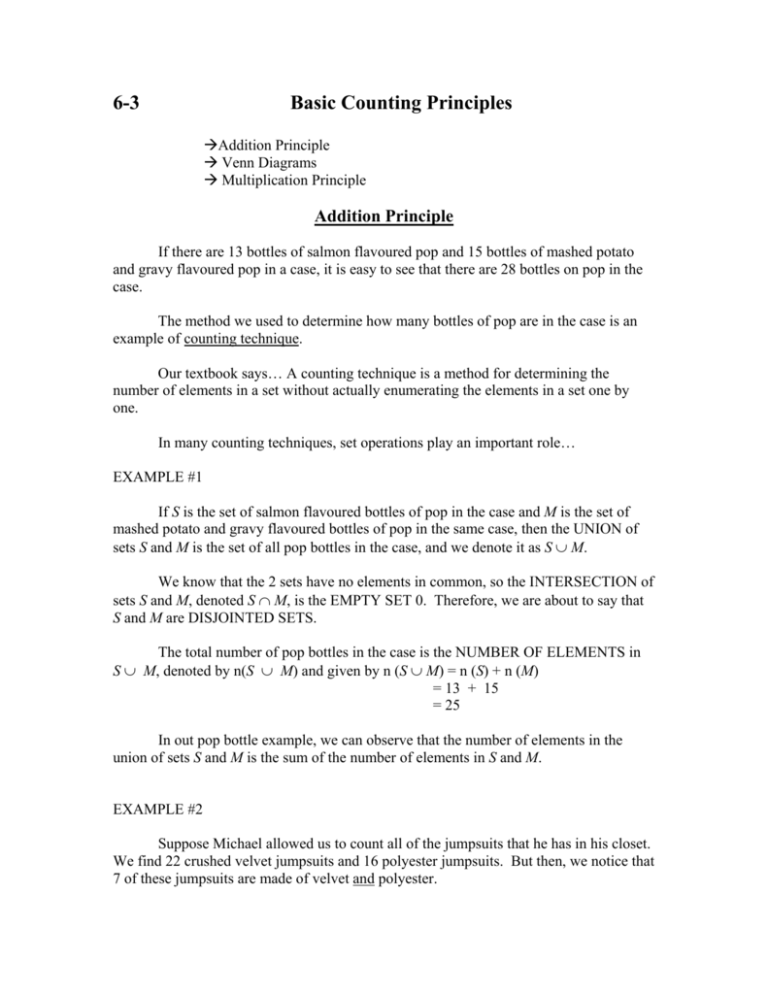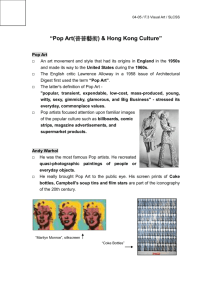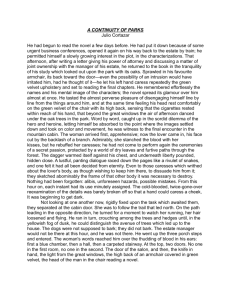6-3 Basic Counting Principles
advertisement

6-3 Basic Counting Principles ÆAddition Principle Æ Venn Diagrams Æ Multiplication Principle Addition Principle If there are 13 bottles of salmon flavoured pop and 15 bottles of mashed potato and gravy flavoured pop in a case, it is easy to see that there are 28 bottles on pop in the case. The method we used to determine how many bottles of pop are in the case is an example of counting technique. Our textbook says… A counting technique is a method for determining the number of elements in a set without actually enumerating the elements in a set one by one. In many counting techniques, set operations play an important role… EXAMPLE #1 If S is the set of salmon flavoured bottles of pop in the case and M is the set of mashed potato and gravy flavoured bottles of pop in the same case, then the UNION of sets S and M is the set of all pop bottles in the case, and we denote it as S ∪ M. We know that the 2 sets have no elements in common, so the INTERSECTION of sets S and M, denoted S ∩ M, is the EMPTY SET 0. Therefore, we are about to say that S and M are DISJOINTED SETS. The total number of pop bottles in the case is the NUMBER OF ELEMENTS in S ∪ M, denoted by n(S ∪ M) and given by n (S ∪ M) = n (S) + n (M) = 13 + 15 = 25 In out pop bottle example, we can observe that the number of elements in the union of sets S and M is the sum of the number of elements in S and M. EXAMPLE #2 Suppose Michael allowed us to count all of the jumpsuits that he has in his closet. We find 22 crushed velvet jumpsuits and 16 polyester jumpsuits. But then, we notice that 7 of these jumpsuits are made of velvet and polyester. If V stands for the set of Michael’s velvet jumpsuits and P stands for the set of Michael’s polyester jumpsuits, then we can say that V ∪ P represents the set of Michael’s jumpsuits that are made of either velvet and polyester or both.. Using what we learned from our pop bottle example lets find out the total number of jumpsuits that are in Michael’s closet… The solution seems obvious. There are 22 velvet and 16 polyester, add them together to solve the problem! 22 velvet + 16 polyester = 38 jumpsuits But what about the 7 jumpsuits that are both, velvet and polyester? Did we count then twice? Yes, we did! We counted the velvet and polyester jumpsuits as velvet first, and then we counted them again when we counted the polyester jumpsuits. So we need to make a new equation to get the solution. We know that we have counted 7 of Michael’s jumpsuits twice, so lets fix our mistake… To correct the double counting, we have to subtract the number of jumpsuits that are made of both velvet and polyester from the first sum that we thought was correct. Number of jumpsuits = Number of velvet jumpsuits + Number of polyester jumpsuits – Number of velvet and polyester jumpsuits. N ( V ∪ P) = n(V) + n(P) - n(V ∩ P) = 22 + 16 - 7 = 31 Michael had 31 jumpsuits! So far we have used two different equations for counting the elements in the union of two sets: . n(S ∪ M) = n(S) + n (M) and n(V ∪ P)= n(V) + n(P) – n(V ∩ P) Both equations are illustrations of the ADDITIONS PRINCIPLE (FOR COUNTING). Addition Principle (for counting) 1.) For any two sets of A and B, . n(A ∪ B) = n(A) + n(B) – n(A ∩ B) 2.2.) If A and B are disjointed then, n(A ∪ B) = n(A) + n(B) Venn Diagrams - Additional set concepts, and useful counting techniques EXAMPLE #3 Market Research A city has two daily newspapers, the Sentinel and the Journal. The following information was obtained from a survey of 100 residents of that city: 35 people subscribe to the Sentinel, 60 subscribe to the Journal, and 20 subscribe to both newspapers. (A) How many people in the survey subscribe to the Sentinel but not to the Journal? (B) How many subscribe to the Journal but no to the Sentinel? (C) How many do not subscribe to either paper? (D) Organize this information in a table. Multiplication Principle Now we know that addition and subtraction are used to count the number of elements in set if the elements are determined by the union and intersection operations. Our next step is to learn about the sets which elements are determined by a sequence of operations… The elements in sets formed in this manner are counted using multiplication. EXAMPLE #4 Product Mix A retail store stocks windbreaker jackets in a small, medium, large and extra large, and all are available in blue or red. What are the combined choices, and how many combined choices are there? To solve this problem, we will use a TREE DIAGRAM… Now that we have our solution, we see that there are 4 possible outcomes in the first operation (choosing a size) and 2 possible outcomes in the second operation (choosing a color). If we use the multiplication principle we see that there are 4 • 2 = 8 possible combined outcomes… Multiplication Principle (for Counting) 1.) If two operations 01 and 02 are performed in order with N1 possible outcomes for the first operation and N2 possible outcomes for the second operation, then there are N1 • N2 possible combined outcome of the first operation followed by the second. 2.) In general, if n operations 01, 02…0n are performed in order, with possible number of outcomes N1, N2 … Nn, respectively, then there are N1 • N2 • …Nn possible combined outcomes of the operations performed in the given order. The multiplication principle will be useful in our next example. Using the tree diagram technique is obviously not an efficient way to solve a problem with large numbers. EXAMPLE #5 From the 26 letters in the alphabet, how many ways can 3 letters in a row be on a license plate, if no letter is repeated? Assignment Exercise 6-3 # 1 – 17 odd, 21-31 odd, 35, 39, 45, 53, 59





